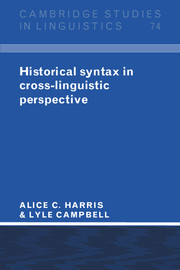Book contents
- Frontmatter
- Contents
- Preface
- List of abbreviations
- 1 Introduction
- 2 The history of historical syntax: major themes
- 3 Overview of a theory of syntactic change
- 4 Reanalysis
- 5 Extension
- 6 Language contact and syntactic borrowing
- 7 Processes that simplify biclausal structures
- 8 Word order
- 9 Alignment
- 10 On the development of complex constructions
- 11 The nature of syntactic change and the issue of causation
- 12 Reconstruction of syntax
- Appendix
- Notes
- References
- Index of languages and language families
- Index of scholars
- Index of subjects
3 - Overview of a theory of syntactic change
Published online by Cambridge University Press: 05 June 2012
- Frontmatter
- Contents
- Preface
- List of abbreviations
- 1 Introduction
- 2 The history of historical syntax: major themes
- 3 Overview of a theory of syntactic change
- 4 Reanalysis
- 5 Extension
- 6 Language contact and syntactic borrowing
- 7 Processes that simplify biclausal structures
- 8 Word order
- 9 Alignment
- 10 On the development of complex constructions
- 11 The nature of syntactic change and the issue of causation
- 12 Reconstruction of syntax
- Appendix
- Notes
- References
- Index of languages and language families
- Index of scholars
- Index of subjects
Summary
In this chapter we begin to lay out a theory of syntactic change. In order to develop such a theory it is necessary to address what the entity upon which change operates is, what the forces of change are, how those forces act upon that entity, and what – if anything – constrains those forces. This chapter introduces our theory of how syntax changes over time, defines some basic terms, and presents some claims about syntactic change that are treated in detail in subsequent chapters.
Basic assumptions about language change
Views of language change have assumed that:
(a) human beings are genetically endowed with aspects of universal grammar which regulate how infants acquire languages and hence determine what constitutes a possible language;
(b) child language acquisition is (in large measure) responsible for linguistic change;
(c) change is abrupt since change occurs in the construction of a new grammar by child language learners which may differ in its internal structure from the grammar of adult models (whose grammars may no longer be optimal due to additions or modifications later in life).
We evaluate each of these in order to make clear the relationship of these assumptions to our own theory. Let us take up the claimed abruptness of syntactic change ((c) above) first.
- Type
- Chapter
- Information
- Historical Syntax in Cross-Linguistic Perspective , pp. 48 - 60Publisher: Cambridge University PressPrint publication year: 1995

